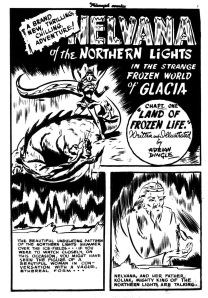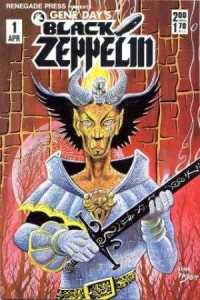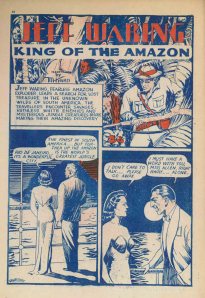The back story is that Canadian comics came into existence because of the war-time ban on American publications. They flourished during the war because they were the only comics available to Canadian youth, and they were very good, but they suffered no competition. I sometimes think this kind of rule should be applied more often, especially in regards to Canadian pop culture, but let’s not open up that can of worms.
Anyway, after the war ended, the ban was lifted, and this was basically the end of Canadian comics as a flourishing industry until about the early nineties. There’s more to it, and here’s where you can find it.
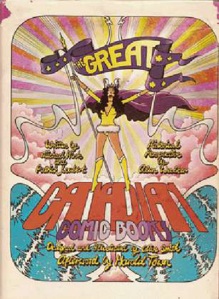 Basically, nothing really happened until 1971. Canadian comics were being produced in different ways, educational, underground, etc., but the first reference book on the subject that talked about superheroes and proper mainstream comics from Canada was Michael Hirsh and Patrick Loubert’s The Great Canadian Comic Books. This book is basically a look into perhaps the most successful, and most Canadian, comics produced during the forties and includes histories and excerpts on almost all facets of the Bell Features collection including Nelvana, The Penguin, Johnny Canuck and popular genres. It was published kind of as a companion to an exhibition that was happening at the time.
Basically, nothing really happened until 1971. Canadian comics were being produced in different ways, educational, underground, etc., but the first reference book on the subject that talked about superheroes and proper mainstream comics from Canada was Michael Hirsh and Patrick Loubert’s The Great Canadian Comic Books. This book is basically a look into perhaps the most successful, and most Canadian, comics produced during the forties and includes histories and excerpts on almost all facets of the Bell Features collection including Nelvana, The Penguin, Johnny Canuck and popular genres. It was published kind of as a companion to an exhibition that was happening at the time.
The introduction by Alan Walker should be taken with a grain of salt as not all of his facts are accurate. The other chapters include The National Gallery of Canadian Heroes, Sports, The Surreal World of Secret Agents, Comic Book Covers, Humour, Western Action, Miscellaneous, The War Spirit, Youngsters Only, Jungle, Adventure, A Stable of Costumed Heroes, Detectives and an Afterword by Harold Town.
 Unfortunately, this book is rare. Published in 1971 by Peter Martin and Associates Limited, it had a smaller print run. Being about comics, Canadian comics even, especially in the seventies, didn’t automatically mean great sales. It was published with two editions, but the only difference is that the second edition has a different cover. You can find it online, but it’s not cheap. The good news is that it was republished in Alter Ego #71. The other good news is that, if you’re on a budget, you can buy a digital copy for cheap, but they do have back issues as well. The bad news is that the republication does not include all of the Bell Features excerpts that the original does. You’ll find a link near the end to purchase these online.
Unfortunately, this book is rare. Published in 1971 by Peter Martin and Associates Limited, it had a smaller print run. Being about comics, Canadian comics even, especially in the seventies, didn’t automatically mean great sales. It was published with two editions, but the only difference is that the second edition has a different cover. You can find it online, but it’s not cheap. The good news is that it was republished in Alter Ego #71. The other good news is that, if you’re on a budget, you can buy a digital copy for cheap, but they do have back issues as well. The bad news is that the republication does not include all of the Bell Features excerpts that the original does. You’ll find a link near the end to purchase these online.
And then nothing again. Well, almost nothing. At this time, the makings of the next great book on the subject were being collected by John Bell. An archivist with Archives Canada since 1975, John Bell had his own archives of comics with everything from fanzines, to underground comics, to one shots and comic anthologies. In 1989 he published the first Canadian comic price guide called Canuck Comics with Matrix Graphics Comics, which is not a complete listing of all the comics up to that time, but some of the more common or popular ones. The book also includes:
- A Publisher’s Preface by Mark Shainblum entitled “Of Canadians and Comic Book People”
- A foreword by Harlan Ellison entitled “Dreams of Joy Recaptured”
- A humourously titled introduction by John Bell called “Yes, There Are Canadian Comics”
- Also by John Bell, “A History of English Canadian Comic Books”
- “The War Years: Anglo-American Publishing Limited” by Robert Macmillan
- Luc Pomerleau’s “Québec Comics: A Short History” in both English and French (La BD Québécois: Bref Historique)
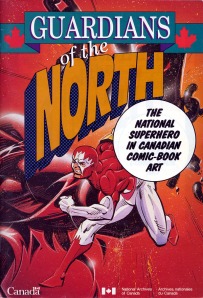 Shortly after the release of this comic, Bell, who had been a curator of the Canadian Museum of Caricature in Ottawa, wrote and published Guardians of the North: The National Superhero in Canadian Comic-Book Art. This small book was released as a program or companion to the 1992 exhibition of the same name, and focuses more on Canadian superheroes. Good luck finding this one. Your best bet is probably a library again, but there are a few available for purchase at a sharp price.
Shortly after the release of this comic, Bell, who had been a curator of the Canadian Museum of Caricature in Ottawa, wrote and published Guardians of the North: The National Superhero in Canadian Comic-Book Art. This small book was released as a program or companion to the 1992 exhibition of the same name, and focuses more on Canadian superheroes. Good luck finding this one. Your best bet is probably a library again, but there are a few available for purchase at a sharp price.
In May 2004, TwoMorrows Publishing released its first issue with a feature on Canadian comics, (I’ve done this a bit backwards) Alter Ego #36 and includes some fantastic pieces. In this issue is:
- “The Golden Age of Canadian Comic Books and Its Aftermath” by John Bell
- “Living in a World of Fantasy” in which Dave Sim talks with Adrian Dingle, Pat Dingle and Bill Thomas
- “My Teacher Was Just Alex Raymond Strips” which is an interview with Jerry Lazare
- “Comic Crypt: Fred Kelly – An Appreciation” by Michael T. Gilbert
- “Les Barker, a.k.a. Leo Bachle” by Robert Pincombe
Like Alter Ego #71, Alter Ego #36 can be purchased in both print and, somewhat cheaper, digitally. Another benefit to having both copies is that issue #36 includes extra pictures (in black and white) and samples of Golden Age comics that #71 does not.
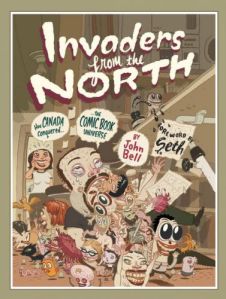 Finally, the real treasure trove of information can be found in John Bell’s Invaders From the North: How Canada Conquered the Comic Book Universe. This was released in 2006 by Dundurn Press in Toronto. It features a concise history of comics in Canada from the man who essentially put it together. Since its publication the book has been remaindered, and is quickly becoming another rare book on a long list of rare books about and of Canadian comics. This is, generally, the height of publications on Canadian comic books. But more information is obviously always available online. A great resource is always Sequential if you check out the blog roll and links section to the right, and I try and keep updated with reliable online references.
Finally, the real treasure trove of information can be found in John Bell’s Invaders From the North: How Canada Conquered the Comic Book Universe. This was released in 2006 by Dundurn Press in Toronto. It features a concise history of comics in Canada from the man who essentially put it together. Since its publication the book has been remaindered, and is quickly becoming another rare book on a long list of rare books about and of Canadian comics. This is, generally, the height of publications on Canadian comic books. But more information is obviously always available online. A great resource is always Sequential if you check out the blog roll and links section to the right, and I try and keep updated with reliable online references.
Sources
Bell, John, ed. Canuck Comics: A Guide to Comic Books Published in Canada. Montreal: Matrix Books, 1986.
Bell, John. Invaders From the North: How Canada Conquered the Comic Book Universe. Toronto: The Dundurn Group, 2006.
Hirsh, Michael. Loubert, Patrick. The Great Canadian Comic Books. Toronto: Peter Martin and Associates, 1970.
Lost Heroes. Pascoe, Will. Wosk, Tony. Toronto: Far Point Films. Middle Child Films, 2014.

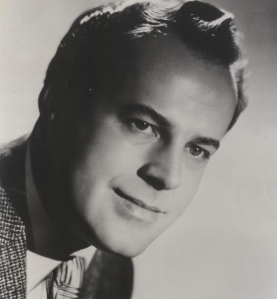 Johnny originally appeared in the first issue of Dime comics, which likely appeared on news stands in late December 1941 or January 1942, but whose publication date is February. Johnny’s creator, Leo Bachle, was just 16 at the time he created the comic for Cy Bell and John Ezrin. Despite Bachle’s youth, Johnny Canuck would go on to be one of Bell Feature’s biggest characters, and indeed, one of the biggest and most lasting characters of the Golden Age. The comic itself is just over 230 pages of comics spread across 28 issues and 7 arcs. The first and last issue are the only issues to be one shots.
Johnny originally appeared in the first issue of Dime comics, which likely appeared on news stands in late December 1941 or January 1942, but whose publication date is February. Johnny’s creator, Leo Bachle, was just 16 at the time he created the comic for Cy Bell and John Ezrin. Despite Bachle’s youth, Johnny Canuck would go on to be one of Bell Feature’s biggest characters, and indeed, one of the biggest and most lasting characters of the Golden Age. The comic itself is just over 230 pages of comics spread across 28 issues and 7 arcs. The first and last issue are the only issues to be one shots.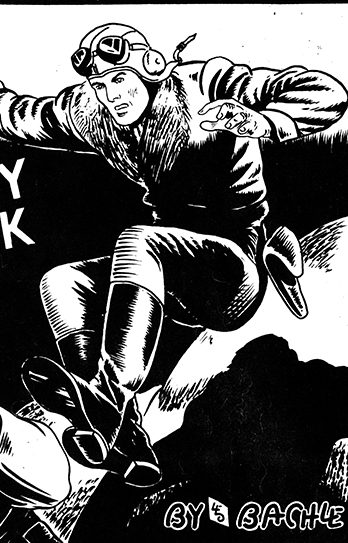 Johnny’s character was kind of a Jack of all trades, a flying ace and fighter, secret agent, and officer in the Canadian military. Most of the time, Johnny was saving “foreign beauties” and fought the axis on almost every war front. He met up with Hitler no fewer than three times and was trained in trapeze and boxing! Throughout his comics he travelled to Yugoslavia, Russia, Germany, Libya, Tibet, and China. It wasn’t until the final issue that Johnny’s story took place in Canada, and just off the coast of Halifax! Interestingly, this story also had a science fiction feel, as this last comic took place after the end of the war, and essentially, after Johnny’s biggest villain was out of the picture!
Johnny’s character was kind of a Jack of all trades, a flying ace and fighter, secret agent, and officer in the Canadian military. Most of the time, Johnny was saving “foreign beauties” and fought the axis on almost every war front. He met up with Hitler no fewer than three times and was trained in trapeze and boxing! Throughout his comics he travelled to Yugoslavia, Russia, Germany, Libya, Tibet, and China. It wasn’t until the final issue that Johnny’s story took place in Canada, and just off the coast of Halifax! Interestingly, this story also had a science fiction feel, as this last comic took place after the end of the war, and essentially, after Johnny’s biggest villain was out of the picture!

